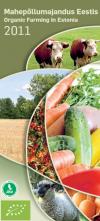 For the fourth time, the brochure "Organic Farming in Estonia" has been published. It informs about the latest facts and figures about organic farming in the country. According to this publication, 14 percent of the agricultural land is now organic (data per end of 2011).
For the fourth time, the brochure "Organic Farming in Estonia" has been published. It informs about the latest facts and figures about organic farming in the country. According to this publication, 14 percent of the agricultural land is now organic (data per end of 2011).
In Estonia, organic land has expanded more than ten-fold since 2000, but processing and marketing has not kept up with this growth. It is, however, expected, that the Estonian Organic Farming Action Plan 2007–2013 and the Estonian Rural Development Plan 2007–2013 will contribute to the expansion of the organic sector in Estonia.
Organic production has grown rapidly in the past years, one of the reasons being the financial support given per organic hectare since the year 2000. By 2011, organic land (134'057 hectares) was about 14 percent of all agricultural land in use, with 1431 organic producers. In addition, 1040 ha natural areas were certified. The average size of farms is 94 hectares. Six of Estonia’s largest organic farms have over 1000 hectares of land.
Development of organic processing and marketing has been modest. In 2011, the organic farming register had a total of 127 organic food processors and traders. Organic products reach consumers mostly via specialist organic shops and direct sales. An increasing amount of products is on sale in conventional stores.
Consumer interest to purchase organic food has increased considerably. The areas of organic processing and marketing will undoubtedly develop soon, making organic food much more widely available, and this is a main aim of the Organic Farming Action Plan 2007–2013.
The brochure is authored by Airi Vetemaa and Merit Mikk of the Estonian Organic Farming Foundation/Centre of Ecological Engineering.
 Download the broshure (1.09 MB)
Download the broshure (1.09 MB)